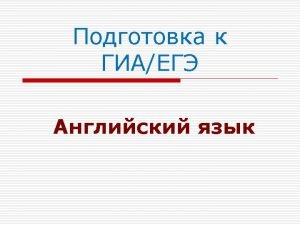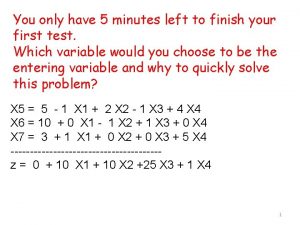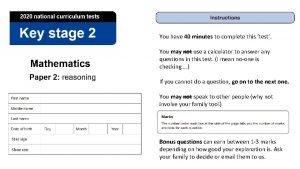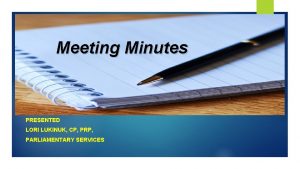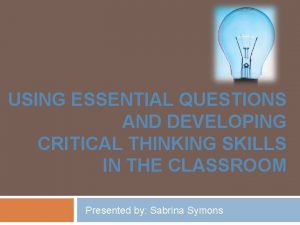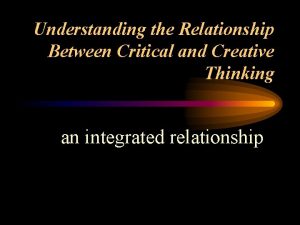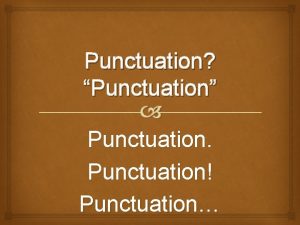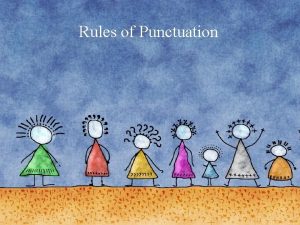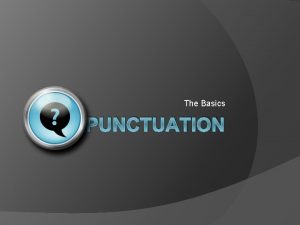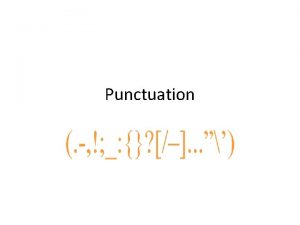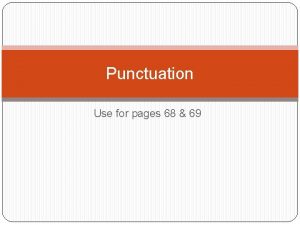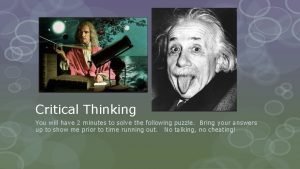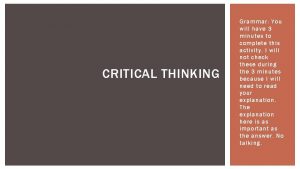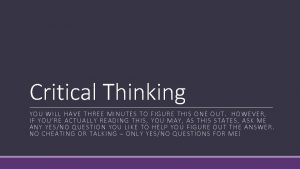CRITICAL THINKING Punctuation You will have 3 minutes


















- Slides: 18

CRITICAL THINKING Punctuation: You will have 3 minutes to provide the correct punctuation to the following series of words so that the series of words makes sense. No cheating or talking.

THE PROBLEM Punctuate the following so it makes sense: "That that is is that is not that it it is. "

THE SOLUTION "That that is, is; that is not, is not. Is not that it? It is. "

GOALS FOR THE DAY If given a rhetorical choice and the author’s argument, purpose, or tone, I can explain how the rhetorical choice helps the author develop the overall argument, purpose, and/or tone.

VOICE LESSON - TONE Consider: What a thrill – My thumb instead of an onion. The top quite gone Except for a sort of a hinge Of skin. A flap like a hat, Dead white. Then a red plush. - Sylvia Plath, “Cut: For Susan O'Neill Roe” Discuss: 1. What is the poet’s attitude toward the cut? What words, images, and details create the tone? 2. In the second stanza, Plath uses colors to intensify the tone. The flap of skin is dead white, the blood is a red plush. What attitude toward the cut and, by implication, toward life itself, does this reveal? Apply: Write a short description of an automobile accident. Create a tone of complete objectivity – as if you were from another planet and had absolutely no emotional reaction to the accident. Read your description to a partner and discuss the details, images, and diction that create your tone.

PARTS OF A SENTENCE REVIEW Complete all of the review pages in the packet. Use additional sheets as review if needed. Come to class on Thursday with any questions you still have. Quiz will be on Friday.

PARTS OF A SENTENCE Part of Sentence Verb Must Be: Look for: Ask: Direct Object Action Subject, Action Verb What? Who? Indirect Object Action Subject, Action Verb, Direct Object To what? For what? To whom? For whom? Objective Complement Action Subject, Action Verb, Direct Object What? Predicate Nominative Linking Subject, Linking Verb Noun? Predicate Adjective Subject, Linking Adjective?

MODELING A QUALITY DISCUSSION Open your book to page 72. Let’s discuss #1. Throw out ideas as to why he may have used abstract words. Take a few of your ideas and try to figure out how this might help him to develop his overall argument. Sometimes it’s not a direct link – there may be several steps that need to be taken to get to his argument.

EXAMPLE: ABSTRACT DICTION John F. Kennedy uses a variety of abstract diction to help set the tone of the speech. In any political situation, there will be differences of opinion. Kennedy clearly understands this, so he uses abstract words that have positive connotations for everyone, not just a single group. Regardless of political affiliation, race, ethnicity, religion, or gender “freedom” is something everyone can all rally around. Everyone respects “devotion” and “loyalty” so using these types of words help him to develop a unifying tone. Even when he shifts to words with negative connotations such as “poverty, ” he uses them to create unity. No one wants to live in poverty or see others live in poverty, so if he can give the impression that we can reduce or eliminate poverty, he hopes nearly all people will rally behind this. His unifying tone is critical to his overall argument as well. His goal is to convince not just the United States but the entire world that the values and beliefs, the freedoms and rights, that our country was built on can be replicated around the globe. But, this cannot be done alone. It will take everyone working together to achieve it, so he must find a way to unify or rally the people of the world toward this single cause. By using abstract diction, he takes his first step toward unifying everyone. Interestingly, these abstract words also help him set a fairly formal tone, which people around the world are also looking for. The abstract words are appropriate to the occasion of a new president of the United States taking office. But, even as one of the most powerful men in the world, he expresses that he will have to make “sacrifices” just as the people will. Knowing that your leader is willing to sacrifice goes a long way in persuading others to sacrifice, so once again, this abstract diction helps to unify people around the globe which is critical to his overall argument.

TAKE YOUR BOOK WITH YOU Group 1 Gill Elkins Hart Group 4 Mayes D. Gray Watkins Group 7 Linderman Kinsey Graninger Group 2 Curtis Eberhard Huff Group 5 Ott Huestis K. Powers Group 8 Kellams Medlock D. Powers Group 3 Simmons Rorie Burns Group 6 Johnson Steinkuhl P. Gray Mason Group 9 Eckels Smith Ackerman

TAKE YOUR BOOK WITH YOU Group 1 Norris Abu-Taqa Sutton Lawrence Group 2 Rudd Herrell Hubbard Group 5 Guzman Boyle Westerfield Group 6 Pease Stinson Bost Group 3 Bushrod Lane Hernandez Group 4 Miller Sigler Johnson

BEGIN WITH A DISCUSSION OF #2, #3, AND #4 How does the author use each of the strategies and how does that impact his overall argument? Think deeply – write down ideas. Try to determine which ideas are BEST supported in the text. Wonder: Ask questions you don’t yet know the answer to. Try to answer them. See if they fit. Draw some conclusions about WHY and HOW the author is using the strategy. Discuss – how would you go about writing a body paragraph about each strategy if you were writing a rhetorical analysis essay?

NOW WRITE! All three of you open your computers to Google Classroom and the JFK paragraphs. As a group, you have 10 minutes to construct a well-organized body paragraph. Each of you play a role One person actually type the essay – share with the rest of the group (group members copy/paste your final product in to your own assignment document). One person be responsible for throwing out ideas as to HOW to write the essay One person constantly be checking if what is being said makes sense and is sufficient – would it be adequate for an AP essay. ALL THREE OF YOU ARE RESPONSIBLE FOR THE WRITING AS A WHOLE – WRITE AS IF THE BEST PARAGRAPH IN THE CLASS WILL RECEIVE 100%, 2 ND BEST WILL RECEIVE 90%, 3 RD BEST WILL RECEIVE 80%, etc.

QUICK CHANGE OF GROUPS – 11 O’CLOCK PARTNER! Go, you have 60 seconds to find your new partner and sit with them.

BEGIN A NEW DISCUSSION ABOUT EITHER #5, #6, #7 OR #10 How does the author use each of the strategies and how does that impact his overall argument? Think deeply – write down ideas. Try to determine which ideas are BEST supported in the text. Wonder: Ask questions you don’t yet know the answer to. Try to answer them. See if they fit. Draw some conclusions about WHY and HOW the author is using the strategy. Discuss – how would you go about writing a body paragraph about each strategy if you were writing a rhetorical analysis essay?

NOW WRITE! All three of you open your computers to Google Classroom and the JFK paragraphs. As a group, you have 10 minutes to construct a well-organized body paragraph. Each of you play a role One person actually type the essay One person be responsible for throwing out ideas as to HOW to write the essay One person constantly be checking if what is being said makes sense and is sufficient – would it be adequate for an AP essay.

TIME TO TRY IT ON YOUR OWN! Quickly look at questions #8, #9, and #10. Choose one of the three you would like to explore. Take a few minutes and think through how the strategy helps the author develop his argument. Organize your thoughts. Write a body paragraph of a rhetorical analysis.

HOMEWORK • Choose one more rhetorical strategy JFK used in his speech. Write a well-organized paragraph expressing how this strategy is used to help JFK develop his overall argument. I should see at least 3 paragraphs completed on this assignment: one done with your group, one done with your partner, and one done on your own. • Voice Lessons for Tone tomorrow. • You will be turning in your Rhetorical Device Book – BRING IT TO CLASS! It’s late if I don’t have it tomorrow. You should be finished with hypophora, rhetorical questions, hyperbole, and understatement. • Quiz Day tomorrow! • Parts of a Sentence Quiz • AP Multiple Choice Quiz – one single passage (10 -15 questions) • Vocabulary #11 Quiz
 Critical semi critical and non critical instruments
Critical semi critical and non critical instruments Semi-critical
Semi-critical Perbedaan critical thinking dan creative thinking
Perbedaan critical thinking dan creative thinking 60 seconds per minute times 60 minutes per hour
60 seconds per minute times 60 minutes per hour What language
What language You have 30 minutes to do this task
You have 30 minutes to do this task You have 20 minutes to do this task
You have 20 minutes to do this task You have 20 minutes to do this task
You have 20 minutes to do this task 5 minutes left
5 minutes left You will have 40 minutes to complete the test.
You will have 40 minutes to complete the test. Thinking about you thinking about me
Thinking about you thinking about me It is not you they are rejecting but me
It is not you they are rejecting but me 1 curved surface 2 flat faces
1 curved surface 2 flat faces Do meeting minutes have to be approved
Do meeting minutes have to be approved Slidetodoc.com
Slidetodoc.com Which is the hardest
Which is the hardest Critical thinking guidelines
Critical thinking guidelines Critical thinking examples
Critical thinking examples Relationship between critical and creative thinking
Relationship between critical and creative thinking





